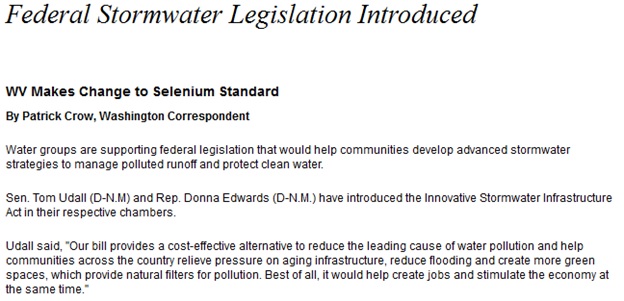A newly-introduced law is currently making the rounds among various water groups offering solutions for effective stormwater BMP (Best Management Practices). Known officially as the “Innovative Stormwater Infrastructure Act of 2013”, the law was proposed by Sen. Tom Udall and Rep. Donna Edwards of New Mexico. Speaking to Waterworld.com correspondent Patrick Crow, Udall explained some of the main provisions of the law and how it aims to positively influence the implementation of water pollution solutions.

Udall said, “Our bill provides a cost-effective alternative to reduce the leading cause of water pollution and help communities across the country relieve pressure on aging infrastructure, reduce flooding and create more green spaces, which provide natural filters for pollution. Best of all, it would help create jobs and stimulate the economy at the same time.”
Also known as “H.R. 3449”, the act requires the Administrator of the Environmental Protection Agency (EPA) to provide competitive grants to eligible higher education institutions. In addition, they research institutions to establish and maintain between three and five centers of excellence for innovative stormwater control infrastructure. The legislation also points out its definition of “innovative stormwater control infrastructure” – any of numerous stormwater BMPs that uses “natural systems or engineered systems that mimic natural processes to infiltrate, evapotranspire, or capture stormwater; and preserves, enhances, or mimics natural hydrology to protect or restore water quality.”
Climate change has been churning out a lot more storms than the world has ever experienced in the past decades. The dreadful fact is, most of these storms are monumentally-devastating. In fact, Typhoon Haiyan – considered to be probably the strongest storm in recorded human history, might seem weaker than the ones soon to hit the world’s shores.
An article on NBC News recently pointed out a report from expert meteorologists suggesting that storm intensities have been steadily rising over decades past. Climate predictions and models also suggest that the intensities can just keep rising for decades to come, raising the potential for bigger, more devastating storms.
Storms not only destroy homes and lives. Storm water carries various pollutants that put water sources at risk of contamination, especially if flooding occurs. Impurities can range from street litter, automotive oil, garden chemicals, and even pet and human waste. One solution to manage such water pollution is by using storm drains to clear off the waste water from streets. Unfortunately, runoff that enters a storm drain is directed to nearest waterways untreated. These bits of information are the main reasons why companies like HydroLogic Solutions, maker of StormChamber, exist – to help protect people from polluted water and prevent contamination of nearby bodies of water.
(Source: Federal Stormwater Legislation Introduced, WaterWorld, March 4, 2014)





